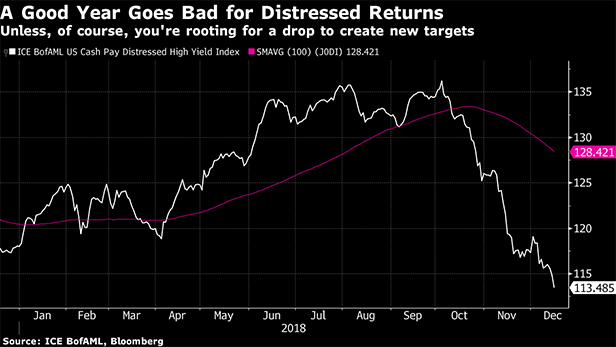At first glance, 2019 might look like a quiet year fordistressed-debt investors, judging by the small list of troubledbonds coming due. But the light schedule may be obscuring howquickly some issuers will unravel.
|As Toys “R” Us demonstrated, weak sales and nervous tradecreditors can bring down a company long before the maturity datesfor loans and bonds. What's more, secured debt isn't as secure asit used to be: Top-heavy capital structures and loose covenantscould leave little for junior creditors to recover if an issuergoes bust.
|Even first-lien holders may have to lower their expectationsbecause of loopholes that weaken their claims on collateral,according to Jeanne Manischewitz, co-head of North American creditat York Capital Management.
|“There's this question mark of how much money is going to belost before you even reach the courthouse steps,” saysManischewitz, whose firm manages $18.2 billion. That may partlyexplain why distressed-debt indexes are now showing negativereturns for the year, but it also creates potential bargains. “Youhave a lot more dislocated credit and debt that trades at a pricethat's below par, which creates more opportunity for total return,”she says.
|
The raw numbers look like this:
|Only $80 billion of loans and $105 billion of speculative-gradebonds will mature through 2020, according to Fitch Ratings. Lookfor trouble at companies saddled with lots of floating-rate debtand shaky business models, Fitch says.
|The default rate for U.S. speculative-grade corporate debt asmeasured by S&P Global Ratings is forecast to drop to 2.25percent by June, from 3 percent a year earlier. The retail andrestaurants sector is worst off, with 15 issues in distress—six ofthem from J.C. Penney Co.
|Covenant quality, as tracked by Moody's Investors Service, hasbeen hovering at its weakest levels for 19 months. Moody's is amongthe voices warning that recoveries could be lower than historicalaverages for first-lien debt in the next downturn because of moreloan-only structures, particularly at issuers owned by privateequity firms.
|Apollo Global Management LLC, one of the biggest investors introubled companies, is playing both sides of covenant risk,according to founder and CEO Leon Black, who says credit marketsare in “bubble status.” At companies that Apollo controls, theprivate equity firm tries to get as much “covenant-less” orcovenant-lite debt as possible, preferably withfixed rates, Black said at a Dec. 5 investment conference. As alender, though, “we're on the opposite side of that equation, andmost of what we do is fairly senior in the capital structure,” hesaid. “It always has covenants, and we try to play a moreconservative, cautious role.”
|Credit markets aren't entirely shut for troubled companies, butstress is showing for “small, midmarket companies, who are thefirst to lose access to capital in uncertain environments,” saysSteve Zelin, who heads restructuring at PJT Partners Inc. “It's notonly a maturity issue, but a constraining cash flow issue and aninability to access the debt markets to solve liquidityconcerns.”
|The shortage of distressed companies is encouraging a moreactivist breed of creditors to scour credit documents for technicalviolations that might amount to defaults, similar to cases such asPetSmart Inc., Neiman Marcus Group Inc., and Windstream HoldingsInc. Those revolve around assertions that asset transfers weakenedcreditor claims on collateral. All three may come to a head in2019. A legal defeat in Windstream's case is unlikely, the companysays, but the stakes are high: A loss could trigger abankruptcy.
|Some issuers find the odds tilted against them when activistcreditors show up already organized and demanding information,before the company even thinks it has a problem, according to JoshSussberg and Jon Henes, partners at law firm Kirkland &Ellis.
|“One of the things that we tell the companies all the time: Youwant to move into these processes on your toes, not on your heels,”Sussberg says. If there's no contingency plan in place, “creditorsare effectively running the show.”
|Some of the bigger distressed debtors still have maneuveringroom left in 2019. Here are the issues they're facing, how theymight cope, and responses from those that answered requests forcomment:
|
Frontier Communications
Among North American issuers, this telecom company has the mostdeeply distressed debt (yields topping 20 percent), at about $12billion. Back in September it told analysts, “We have the abilityto comfortably manage our debt maturities over the coming fewyears,” and Bloomberg Intelligence (BI) says Frontier can meetabout $700 million of payments for 2019 through 2020 with itsrevolver and free cash flow. After that, GimmeCredit wonders howFrontier can meet obligations in 2021 and 2022. Fundamentalpressures include erosion of voice, video, and broadbandrevenue.
|
Community Health Systems
It's selling underperforming hospitals to cut its debt load ofmore than $13 billion. Refinancing deals narrowly averted arestructuring, according to BI's Mike Holland. Even then, he wrote,“we remain skeptical of the company's ability to make enoughcredit-accretive sales to grow into its capital structure, andbelieve that future debt refinancings will be challenged by EBITDAerosion amid excessive leverage.”
|
Neiman Marcus
The first round of restructuring talks ended in stalemate, withnegotiators tangling over the transfer of MyTheresa, the promisingonline unit. Marble Ridge Capital has sued, but the company saysthe transaction was “expressly permitted” by its debt documents.Talks are likely to restart early this year; the court case inDallas federal court is just getting started. About $5 billion ofdebt is involved. All of Neiman's stores show positive EBITDA, it'scomplying with all debt requirements, and there's ample time torefinance, Neiman said in an emailed statement. “We view thesenegotiations as an ongoing process that will likely take time,”Neiman said. “We believe a mutually beneficial solution can bereached.”
|
J.C. Penney
The retailer is saddled with around $4 billion of debt and weaksales; it didn't help that the chain was leaderless for months. Thenew team is “comfortable” with liquidity and maturities, andBloomberg Intelligence sees enough flexibility and vendor supportfor Penney to finish dumping old inventory and refreshing itsofferings. But not all bondholders are so confident; yields on somenotes top 20 percent. J.C Penney has a “manageable maturityschedule” and “clear runway” for the next several years before itsnext meaningful debt maturity in 2036, a representative said in astatement.
||
From: Bloomberg
|Copyright 2019 Bloomberg. All rightsreserved. This material may not be published, broadcast, rewritten,or redistributed.
Complete your profile to continue reading and get FREE access to Treasury & Risk, part of your ALM digital membership.
Your access to unlimited Treasury & Risk content isn’t changing.
Once you are an ALM digital member, you’ll receive:
- Critical Treasury & Risk information including in-depth analysis of treasury and finance best practices, case studies with corporate innovators, informative newsletters, educational webcasts and videos, and resources from industry leaders.
- Exclusive discounts on ALM and Treasury & Risk events.
- Access to other award-winning ALM websites including PropertyCasualty360.com and Law.com.
*May exclude premium content
Already have an account? Sign In
© 2024 ALM Global, LLC, All Rights Reserved. Request academic re-use from www.copyright.com. All other uses, submit a request to [email protected]. For more information visit Asset & Logo Licensing.







